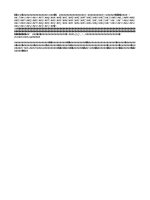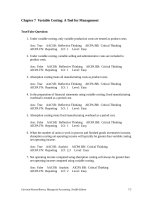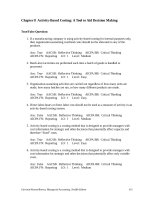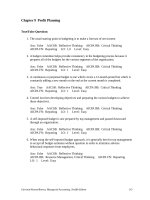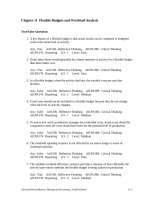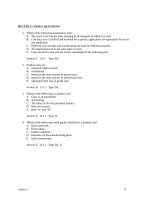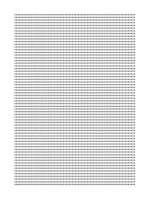Test bank managerial accounting by hilton 9e chapter14
Bạn đang xem bản rút gọn của tài liệu. Xem và tải ngay bản đầy đủ của tài liệu tại đây (173.12 KB, 38 trang )
MULTIPLE CHOICE QUESTIONS
1. Managerial accountants:
A. rarely become involved in an organization's decision-making activities.
B. make decisions that focus solely on an organization's accounting matters.
C. collect data and provide information so that decisions can be made.
D. often serve as a cross-functional team member, making a wide range of decisions.
E. become involved in activities "C" and "D."
Answer: E LO: 1 Type: RC
2. Factors in a decision problem that cannot be expressed in numerical terms are:
A. qualitative in nature.
B. quantitative in nature.
C. predictive in nature.
D. sensitive in nature.
E. uncertain in nature.
Answer: A LO: 2 Type: RC
3. At which step or steps in the decision-making process do qualitative considerations generally
have the greatest impact?
A. Specifying the criterion and identifying the alternatives.
B. Developing a decision model.
C. Collecting the data.
D. Making a decision.
E. Identifying the alternatives.
Answer: D LO: 2 Type: RC
4. An accounting information system should be designed to provide information that is useful.
To be useful the information must be:
A. qualitative rather than quantitative.
B. unique and unavailable through other sources.
C. historical in nature and not purport to predict the future.
D. marginal between two alternatives.
E. relevant, accurate, and timely.
Answer: E LO: 2 Type: RC
150
Hilton, Managerial Accounting, Seventh Edition
5. To be useful in decision making, information should possess which of the
following characteristics?
Relevance
Accuracy
Timeliness
A.
Yes
No
Yes
B.
Yes
Yes
No
C.
Yes
Yes
Yes
D.
No
Yes
Yes
E.
No
No
Yes
Answer: C LO: 2 Type: RC
6. A trade-off in a decision situation sometimes occurs between information:
A. accuracy and relevance.
B. relevance and uniqueness.
C. accuracy and timeliness.
D. sensitivity and accuracy.
E. sensitivity and relevance.
Answer: C LO: 2 Type: RC
7. Which of the following best defines the concept of a relevant cost?
A. A past cost that is the same among alternatives.
B. A past cost that differs among alternatives.
C. A future cost that is the same among alternatives.
D. A future cost that differs among alternatives.
E. A cost that is based on past experience.
Answer: D LO: 3 Type: RC
8. Consider the following costs and decision-making situations:
I.The cost of existing inventory, in a keep vs. disposal decision.
II.The cost of special electrical wiring, in an equipment acquisition decision.
III.The salary of a supervisor who will be transferred elsewhere in the organization, in a
department-closure decision.
Which of the above costs is (are) relevant to the decision situation noted?
A. I only.
B. II only.
C. III only.
D. I and II.
E. II and III.
Answer: B LO: 3 Type: N
151
Hilton, Managerial Accounting, Seventh Edition
9. The following costs are relevant to the decision situation cited except:
A. the cost of hiring a full-time staff attorney, in a decision to establish an in-house legal
department or retain the services of a prominent law firm.
B. the remodeling cost of existing office space, in a firm's decision to stay at its current
location or move to a new building.
C. the long-term salary costs demanded by Joe Torrez (a superstar) and Rip Moran (an
average player) in baseball contract negotiations, in a decision that determines the
amounts by which ticket prices must be raised.
D. the cost to enhance an airline's Web site, in a decision to expand existing service to either
Salt Lake City or Phoenix.
E. the commissions that could be earned by a salesperson, in a decision that involves
salesperson compensation methods (i.e., commissions or flat monthly salaries).
Answer: D LO: 3 Type: N
10. Which of the following costs can be ignored when making a decision?
A. Opportunity costs.
B. Differential costs.
C. Sunk costs.
D. Relevant costs.
E. All future costs.
Answer: C LO: 4 Type: RC
11. The book value of equipment currently owned by a firm is an example of a(n):
A. future cost.
B. differential cost.
C. comparative cost.
D. opportunity cost.
E. sunk cost.
Answer: E LO: 4 Type: RC
12. The cost of inventory currently owned by a firm is an example of a(n):
A. opportunity cost.
B. sunk cost.
C. relevant cost.
D. differential cost.
E. future cost.
Answer: B LO: 4 Type: RC
Chapter 14
152
13. The City of Miami is about to replace an old fire truck with a new vehicle in an effort to save
maintenance and other operating costs. Which of the following items, all related to the
transaction, would not be considered in the decision?
A. Purchase price of the new vehicle.
B. Purchase price of the old vehicle.
C. Savings in operating costs as a result of the new vehicle.
D. Proceeds from disposal of the old vehicle.
E. Future depreciation on the new vehicle.
Answer: B LO: 4 Type: N
14. Elegant, Inc., has $125,000 of inventory that suffered minor smoke damage from a fire in the
warehouse. The company can sell the goods "as is" for $45,000; alternatively, the goods can
be cleaned and shipped to the firm's outlet center at a cost of $23,000. There the goods could
be sold for $80,000. What alternative is more desirable and what is the relevant cost for that
alternative?
A. Sell "as is," $125,000.
B. Clean and ship to outlet center, $23,000.
C. Clean and ship to outlet center, $103,000.
D. Clean and ship to outlet center, $148,000.
E. Neither alternative is desirable, as both produce a loss for the firm.
Answer: B LO: 4 Type: A, N
15. In early July, Mike Gottfried purchased a $70 ticket to the December 15 game of the Chicago
Titans. (The Titans belong to the Midwest Football League and play their games outdoors on
the shore of Lake Michigan.) Parking for the game was expected to cost approximately $22,
and Gottfried would probably spend another $15 for a souvenir program and food. It is now
December 14. The Titans were having a miserable season and the temperature was expected
to peak at 5 degrees on game day. Mike therefore decided to skip the game and took his wife
to the movies, with tickets and dinner costing $50. The sunk cost associated with this decision
situation is:
A. $20.
B. $50.
C. $70.
D. $107.
E. some other amount.
Answer: C LO: 4 Type: A
153
Hilton, Managerial Accounting, Seventh Edition
16. In early July, Jim Lopez purchased a $70 ticket to the December 15 game of the Chicago
Titans. (The Titans belong to the Midwest Football League and play their games outdoors on
the shore of Lake Michigan.) Parking for the game was expected to cost approximately $22,
and Lopez would probably spend another $15 for a souvenir program and food. It is now
December 14. The Titans were having a miserable season and the temperature was expected
to peak at 5 degrees on game day. Jim therefore decided to skip the game and took his wife to
the movies, with tickets and dinner costing $50. The amount of sunk cost that should
influence Jim’s decision to take his wife to the movies and dinner is:
A. $0.
B. $20.
C. $50.
D. $70.
E. some other amount.
Answer: A LO: 4 Type: A, N
17. An opportunity cost may be described as:
A. a forgone benefit.
B. an historical cost.
C. a specialized type of variable cost.
D. a specialized type of fixed cost.
E. a specialized type of semivariable cost.
Answer: A LO: 4 Type: RC
18. The term "opportunity cost" is best defined as:
A. the amount of money paid for an item.
B. the amount of money paid for an item, taking inflation into account.
C. the amount of money paid for an item, taking possible discounts into account.
D. the benefit associated with a rejected alternative when making a choice.
E. an irrelevant decision factor.
Answer: D LO: 4 Type: RC
19. A factory that makes a part has significant idle capacity. The factory's opportunity cost of
making this part is equal to:
A. the variable manufacturing cost per unit.
B. the fixed manufacturing cost per unit.
C. the semivariable cost per unit.
D. the total manufacturing cost per unit.
E. zero.
Answer: E LO: 4 Type: N
Chapter 14
154
20. Susan is contemplating a job offer with an advertising agency where she will make $54,000 in
her first year of employment. Alternatively, Susan can begin to work in her father's business
where she will earn an annual salary of $38,000. If Susan decides to work with her father, the
opportunity cost would be:
A. $0.
B. $38,000.
C. $54,000.
D. $92,000.
E. irrelevant in deciding which job offer to accept.
Answer: C LO: 4 Type: A
21. Which of the following costs should be used when choosing between two
decision alternatives?
Relevant
Sunk
Opportunity
Cost
Cost
Cost
A.
No
Yes
No
B.
No
Yes
Yes
C.
Yes
No
No
D.
Yes
No
Yes
E.
Yes
Yes
Yes
Answer: D LO: 4 Type: RC
22.
Triumph, Inc., is studying whether to expand operations by adding a new
product line. Which of the following choices correctly denotes the costs that should
be considered in this decision?
A.
B.
C.
D.
E.
Opportunity Cost
Yes
Yes
Yes
No
No
Sunk Cost
Yes
Sometimes
No
Yes
No
Answer: C LO: 4 Type: RC
23. A special order generally should be accepted if:
A. its revenue exceeds allocated fixed costs, regardless of the variable costs associated with
the order.
B. excess capacity exists and the revenue exceeds all variable costs associated with the order.
C. excess capacity exists and the revenue exceeds allocated fixed costs.
D. the revenue exceeds total costs, regardless of available capacity.
E. the revenue exceeds variable costs, regardless of available capacity.
Answer: B LO: 5 Type: RC
155
Hilton, Managerial Accounting, Seventh Edition
24. Two months ago, Victory purchased 4,500 pounds of Hydrol, paying $15,300. The market for
this product has been very strong since the acquisition, with the market price jumping to $4.05
per pound. (Victory can buy or sell Hydrol at this price.) The company recently received a
special-order inquiry, one that would require the use of 4,200 pounds of Hydrol. Which of the
following is (are) relevant in deciding whether to accept the special order?
A. The 300-pound remaining inventory of Hydrol.
B. The $4.05 market price.
C. The $3.40 purchase price.
D. 4,500 pounds of Hydrol.
E. More than one of the above factors are relevant.
Answer: B LO: 5 Type: A, N
25. Flower Company, which is operating at capacity, desires to add a new service to its rapidly
expanding business. The service should be added as long as service revenues exceed:
A. variable costs.
B. fixed costs.
C. the sum of variable costs and fixed costs.
D. the sum of variable costs and any related opportunity costs.
E. the sum of variable costs, fixed costs, and any related opportunity costs.
Answer: D LO: 5 Type: N
26. Baxter has been approached about providing a new service to its clients. The company will
bill clients $120 per hour; the related hourly variable and fixed operating costs will be $65 and
$15, respectively. If all employees are currently working at full capacity on other client
matters, the per-hour opportunity cost of being unable to provide this new service is:
A. $0.
B. $40.
C. $55.
D. $80.
E. $120.
Answer: C LO: 4, 5 Type: A
Chapter 14
156
27. Snider, Inc., which has excess capacity, received a special order for 4,000 units at a price of
$15 per unit. Currently, production and sales are budgeted for 10,000 units without
considering the special order. Budget information for the current year follows.
Sales
Less: Cost of goods sold
Gross margin
$190,000
145,000
$ 45,000
Cost of goods sold includes $30,000 of fixed manufacturing cost. If the special order is
accepted, the company's income will:
A. increase by $2,000.
B. decrease by $2,000.
C. increase by $14,000.
D. decrease by $14,000.
E. change by some other amount.
Answer: C LO: 5 Type: A
28. Sound, Inc., reported the following results from the sale of 24,000 units of IT-54:
Sales
Variable manufacturing costs
Fixed manufacturing costs
Variable selling costs
Fixed administrative costs
$528,000
288,000
120,000
52,800
35,200
Rhythm Company has offered to purchase 3,000 IT-54s at $16 each. Sound has available
capacity, and the president is in favor of accepting the order. She feels it would be profitable
because no variable selling costs will be incurred. The plant manager is opposed because the
"full cost" of production is $17. Which of the following correctly notes the change in income
if the special order is accepted?
A. $3,000 decrease.
B. $3,000 increase.
C. $12,000 decrease.
D. $12,000 increase.
E. None of the above.
Answer: D LO: 5 Type: A
157
Hilton, Managerial Accounting, Seventh Edition
29. CompTronics, a manufacturer of computer peripherals, has excess capacity. The company's
Utah plant has the following per-unit cost structure for item no. 89:
Variable manufacturing
Fixed manufacturing
Variable selling
Fixed selling
Traceable fixed administrative
Allocated administrative
$40
15
8
11
4
2
The traceable fixed administrative cost was incurred at the Utah plant; in contrast, the
allocated administrative cost represents a "fair share" of CompTronics' corporate overhead.
Utah has been presented with a special order of 5,000 units of item no. 89 on which no selling
cost will be incurred. The proper relevant cost in deciding whether to accept this special order
would be:
A. $40.
B. $59.
C. $61.
D. $80.
E. some other amount.
Answer: A LO: 5 Type: A
30. The term "outsourcing" is most closely associated with:
A. special-order decisions.
B. make-or-buy decisions.
C. equipment replacement decisions.
D. decisions to process joint products beyond the split-off point.
E. decisions that involve limited resources.
Answer: B LO: 5 Type: RC
31. Torrey Pines is studying whether to outsource its Human Resources (H/R) activities. Salaried
professionals who earn $390,000 would be terminated; in contrast, administrative assistants
who earn $120,000 would be transferred elsewhere in the organization. Miscellaneous
departmental overhead (e.g., supplies, copy charges, overnight delivery) is expected to
decrease by $30,000, and $25,000 of corporate overhead, previously allocated to Human
Resources, would be picked up by other departments. If Torrey Pines can secure needed H/R
services locally for $410,000, how much would the company benefit by outsourcing?
A. $10,000.
B. $35,000.
C. $130,000.
D. $155,000.
E. Nothing, as it would be cheaper to keep the department open.
Answer: A LO: 5 Type: A
Chapter 14
158
32. Donnelly, a division of Dakota Enterprises, currently makes 100,000 units of a product that
has created a number of manufacturing problems. Donnelly's costs follow.
Manufacturing costs:
Variable
Fixed
Allocated corporate administrative cost
$420,000
150,000
70,000
If Donnelly were to discontinue production, fixed manufacturing costs would be reduced by
80%. The relevant cost of deciding whether the division should purchase the product from an
outside supplier is:
A. $420,000.
B. $490,000.
C. $540,000.
D. $570,000.
E. $640,000.
Answer: C LO: 5 Type: A
33. Maddox, a division of Stanley Enterprises, currently performs computer services for various
departments of the firm. One of the services has created a number of operating problems, and
management is exploring whether to outsource the service to a consultant. Traceable variable
and fixed operating costs total $80,000 and $25,000, respectively, in addition to $18,000 of
corporate administrative overhead allocated from Stanley. If Maddox were to use the outside
consultant, fixed operating costs would be reduced by 70%. The irrelevant costs in Maddox's
outsourcing decision total:
A. $17,500.
B. $18,000.
C. $25,000.
D. $25,500.
E. some other amount.
Answer: D LO: 5 Type: A
34. Which of the following statements regarding costs and decision making is correct?
A. Fixed costs must be considered only on a per-unit basis.
B. Per-unit fixed cost amounts are valid only for make-or-buy decisions.
C. Per-unit fixed costs can be misleading because such amounts appear to behave as variable
costs when, in actuality, the amounts are related to fixed expenditures.
D. Sunk costs can be misleading in make-or-buy decisions because these amounts appear to
be relevant differential costs.
E. Opportunity costs should be ignored when evaluating decision alternatives.
Answer: C LO: 5 Type: RC
159
Hilton, Managerial Accounting, Seventh Edition
35. An architecture firm currently offers services that appeal to both individuals and commercial
clients. If the firm decides to discontinue services to individuals because of ongoing losses,
which of the following costs could the company likely avoid?
A. Allocated corporate overhead.
B. Building depreciation.
C. Insurance.
D. Variable operating costs.
E. Monthly installment payments on general-purpose, computer drafting equipment.
Answer: D LO: 5 Type: N
36. Occidental is contemplating dropping a product because of ongoing losses. Costs that would
be relevant in this situation would include variable manufacturing costs as well as:
A. factory depreciation.
B. avoidable fixed costs.
C. unavoidable fixed costs.
D. allocated corporate administrative costs.
E. general corporate advertising.
Answer: B LO: 5 Type: RC
37. Coastal Airlines has a significant presence at the San Jose International Airport and therefore
operates the Emerald Club, which is across from gate 36 in terminal 1. The Emerald Club
provides food and business services (e.g., data ports) for the company's frequent flyers.
Consider the following selected costs of Club operation:
1.
2.
3.
4.
5.
Receptionist and supervisory salaries
Catering
Terminal depreciation (based on square footage)
Airport fees (computed as a percentage of club revenue)
Allocated Coastal administrative overhead
Management is exploring whether to close the club and expand the seating area for gate 36.
Which of the preceding expenses would the airline classify as unavoidable?
A. 3.
B. 4.
C. 5.
D. 3, 5.
E. The correct answer is not listed.
Answer: D LO: 5 Type: N
Chapter 14
160
38. The Shoe Department at the Baton Rouge Department Store is being considered for closure.
The following information relates to shoe activity:
Sales revenue
Variable costs:
Cost of goods sold
Sales commissions
Fixed operating costs
$350,000
280,000
30,000
90,000
If 70% of the fixed operating costs are avoidable, should the Shoe Department be closed?
A. Yes, Baton Rouge would be better off by $23,000.
B. Yes, Baton Rouge would be better off by $50,000.
C. No, Baton Rouge would be worse off by $13,000.
D. No, Baton Rouge would be worse off by $40,000.
E. None of the above.
Answer: A LO: 5 Type: A
39. Somerset Corporation is composed of five divisions, and each division is allocated a share of
Somerset overhead to make divisional managers aware of the cost of running the corporate
headquarters. The following information relates to the Metro Division:
Sales
Variable operating costs
Traceable fixed operating costs
Allocated corporate overhead
$7,500,000
5,100,000
1,900,000
300,000
If the Metro Division is closed, 100% of the traceable fixed operating costs can be eliminated.
What will be the impact on Somerset's overall profitability if the Metro Division is closed?
A. Decrease by $200,000.
B. Decrease by $500,000.
C. Decrease by $2,100,000.
D. Decrease by $2,400,000.
E. None of the above.
Answer: B LO: 5 Type: A
40. Ortega Interiors provides design services to residential and commercial clients. The
residential services produce a contribution margin of $450,000 and have traceable fixed
operating costs of $480,000. Management is studying whether to drop the residential
operation. If closed, the fixed operating costs will fall by $370,000 and Ortega's net income
will:
A. increase by $30,000.
B. increase by $80,000.
C. increase by $340,000.
D. decrease by $80,000.
E. decrease by $340,000.
Answer: D LO: 5 Type: A
161
Hilton, Managerial Accounting, Seventh Edition
Use the following to answer questions 41-42:
HiTech manufactures two products: Regular and Super. The results of operations for 20x1 follow.
Units
Sales
Less: Cost of goods sold
Gross margin
Less: Selling expenses
Operating income
Regular
10,000
$240,000
180,000
$ 60,000
60,000
$
0
Super
3,700
$740,000
481,000
$259,000
134,000
$125,000
Total
13,700
$980,000
661,000
$319,000
194,000
$125,000
Fixed manufacturing costs included in cost of goods sold amount to $3 per unit for Regular and $20
per unit for Super. Variable selling expenses are $4 per unit for Regular and $20 per unit for Super;
remaining selling amounts are fixed.
41. HiTech wants to drop the Regular product line. If the line is dropped, company-wide fixed
manufacturing costs would fall by 10% because there is no alternative use of the facilities.
What would be the impact on operating income if Regular is discontinued?
A. $0.
B. $10,400 increase.
C. $20,000 increase.
D. $39,600 decrease.
E. None of the above.
Answer: D LO: 5 Type: A
42. Disregard the information in the previous question. If HiTech eliminates Regular and uses the
available capacity to produce and sell an additional 1,500 units of Super, what would be the
impact on operating income?
A. $28,000 increase
B. $45,000 increase
C. $55,000 increase
D. $85,000 increase
E. None of the above.
Answer: C LO: 5 Type: A
43. When deciding whether to sell a product at the split-off point or process it further, joint costs
are not usually relevant because:
A. such amounts do not help to increase sales revenue.
B. such amounts only slightly increase a company's sales margin.
C. such amounts are sunk and do not change with the decision.
D. the sales revenue does not decrease to the extent that it should, if compared with separable
processing.
E. such amounts reflect opportunity costs.
Answer: C LO: 6 Type: RC
Chapter 14
162
44. Product costs incurred after the split-off point in a joint processing environment are termed:
A. separable processing costs.
B. joint product costs.
C. non-relevant costs.
D. scrap costs.
E. spoilage costs.
Answer: A LO: 6 Type: RC
45. Foster Company is considering whether to sell Retox at the split-off point or subject it to
further processing and produce a more refined product known as Retox-F. Consider the
following items:
I.The selling price of Retox-F
II.The joint processing cost of Retox.
III.The separable cost of producing Retox-F.
Which of the above items is (are) relevant to Foster's decision to process Retox into Retox-F?
A. I only.
B. II only.
C. III only.
D. I and II.
E. I and III.
Answer: E LO: 6 Type: RC
46. Lido manufactures A and B from a joint process (cost = $80,000). Five thousand pounds of A
can be sold at split-off for $20 per pound or processed further at an additional cost of $20,000
and then sold for $25. Ten thousand pounds of B can be sold at split-off for $15 per pound or
processed further at an additional cost of $20,000 and later sold for $16. If Lido decides to
process B beyond the split-off point, operating income will:
A. increase by $10,000.
B. increase by $20,000.
C. decrease by $10,000.
D. decrease by $20,000.
E. decrease by $58,000.
Answer: C LO: 6 Type: A
163
Hilton, Managerial Accounting, Seventh Edition
47. India Corporation has $200,000 of joint processing costs and is studying whether to process J
and K beyond the split-off point. Information about J and K follows.
Tons produced
Separable variable processing costs beyond split-off
Selling price per ton at split-off
Selling price per ton after additional processing
Product J
25,000
$64,000
15
21
Product K
15,000
$100,000
52
58
If India desires to maximize total company income, what should the firm do
with regard to Products J and K?
Product J
Product K
A. Sell at split-off
Sell at split-off
B. Sell at split-off
Process beyond split-off
C. Process beyond split-off
Sell at split-off
D. Process beyond split-off
Process beyond split-off
E. There is not enough information to judge.
Answer: C LO: 6 Type: A
48. A company that is operating at full capacity should emphasize those products and services that
have the:
A. lowest total per-unit costs.
B. highest contribution margin per unit.
C. highest contribution margin per unit of scarce resource.
D. highest operating income.
E. highest sales volume.
Answer: C LO: 6 Type: RC
49. A firm that decides to emphasize those goods with the highest contribution margin per unit
may have made an incorrect decision when the company:
A. is highly automated.
B. has excess capacity.
C. has capacity constraints in the form of limited resources.
D. has a high fixed-cost structure.
E. has a high level of sunk costs.
Answer: C LO: 6 Type: N
Chapter 14
164
50. Wright Enterprises, which produces various goods, has limited processing hours at its
manufacturing plant. The following data apply to product no. 607:
Sales price per unit: $9.60
Variable cost per unit: $6.20
Process time per unit: 4 hours
Management is now studying whether to devote the firm's limited hours to product no. 607 or
to other products. What key dollar amount should management focus on when determining
no. 607's "value" to the firm and deciding the best course of action to follow?
A. $0.85.
B. $2.40.
C. $3.40.
D. $6.20.
E. $9.60.
Answer: A LO: 6 Type: A, N
51. Smith Manufacturing has 27,000 labor hours available for producing X and Y. Consider the
following information:
Required labor time per unit (hours)
Maximum demand (units)
Contribution margin per unit
Contribution margin per labor hour
Product X
2
6,000
$5.00
$2.50
Product Y
3
8,000
$6.00
$2.00
If Smith follows proper managerial accounting practices, which of the
following production schedules should the company set?
Product X
Product Y
A. 0 units
8,000 units
B. 1,500 units
8,000 units
C. 6,000 units
0 units
D. 6,000 units
5,000 units
E. 6,000 units
8,000 units
Answer: D LO: 6 Type: A
165
Hilton, Managerial Accounting, Seventh Edition
52. Bush Manufacturing has 31,000 labor hours available for producing M and N. Consider the
following information:
Required labor time per unit (hours)
Maximum demand (units)
Contribution margin per unit
Contribution margin per labor hour
Product M
2
6,500
$5.00
$2.50
Product N
3
8,000
$5.70
$1.90
If Bush follows proper managerial accounting practices in terms of setting a production
schedule, how much contribution margin would the company expect to generate?
A. $31,450.
B. $63,100.
C. $66,700.
D. $78,100.
E. None of the above.
Answer: C LO: 6 Type: A
Use the following to answer questions 53-54:
Johnson Company makes two products: Carpet Kleen and Floor Deodorizer. Operating information
from the previous year follows.
Units produced and sold
Machine hours used
Sales price per unit
Variable cost per unit
Carpet Kleen
5,000
5,000
$7
$4
Floor Deodorizer
4,000
2,000
$10
$8
Fixed costs of $20,000 per year are presently allocated equally between both products. If the product
mix were to change, total fixed costs would remain the same.
53. The contribution margin per machine hour for Floor Deodorizer is:
A. $0.25.
B. $2.00.
C. $4.00.
D. $5.00.
E. $20.00.
Answer: C LO: 6 Type: A
Chapter 14
166
54. Assuming there is unlimited demand for both products and Johnson has
10,000 machine hours available, how many units of each product should
be produced and sold?
Carpet Kleen
Floor Deodorizer
A. 0 units
0 units
B. 0 units
20,000 units
C. 5,000 units
10,000 units
D. 8,000 units
4,000 units
E.
10,000 units
0 units
Answer: B LO: 6 Type: A, N
55. A technique that is useful in exploring what would happen if a key decision prediction or
assumption proved wrong is termed:
A. sensitivity analysis.
B. uncertainty analysis.
C. project analysis.
D. linear programming.
E. the theory of constraints.
Answer: A LO: 6 Type: RC
56. Which of the following characteristics would best explain the use of probabilities and
expected values in a decision analysis?
A. Limited resources.
B. Uncertainty.
C. Inflation.
D. Multiple products and services.
E. Production bottlenecks.
Answer: B LO: 6 Type: RC
57. Consider the following statements about relevant costing and activity-based costing:
I.The concept of relevant costs and benefits cannot be used in conjunction with an activitybased costing system.
II.The concept of relevant costs and benefits must be modified for use with an activity-based
costing system.
III.Generally speaking, the decision maker can better associate relevant costs with the
activities that drive them under an activity-based costing system than under a
conventional product-costing system.
Which of the above statements is (are) true?
A. I only.
B. II only.
C. III only.
D. I and II.
E. II and III.
167
Hilton, Managerial Accounting, Seventh Edition
Answer: C LO: 7 Type: RC
Chapter 14
168
58. Linear programming would be used by decision makers when there are:
A. limited resources for labor.
B. scarce resources for machine hours.
C. scarce resources for both labor and machine hours.
D. multiple scarce resources.
E. limited resources for material.
Answer: D LO: 8 Type: RC
59. A constraint function in a linear-programming problem might focus on:
A. sales dollars.
B. labor hours.
C. variable costs.
D. fixed costs.
E. qualitative factors.
Answer: B LO: 8 Type: N
60. When using a graphical solution to a linear programming problem, the optimal solution will
lie in an area commonly known as the:
A. region of maximization.
B. feasible region.
C. objective region.
D. constraint region.
E. curvilinear region.
Answer: B LO: 8 Type: RC
Use the following to answer questions 61-62:
Prudential Corporation manufactures two products: X and Y. The company has 4,000 hours of
machine time available and can sell no more than 800 units of product X. Other pertinent data follow.
Selling price
Variable cost
Fixed cost
Machine time per unit
Product X
$8.00
3.00
3.50
2 hours
Product Y
$19.00
5.00
6.25
3 hours
61. Which of the following is Prudential's objective function?
A. Maximize Z = 2X + 3Y.
B. Maximize Z = 8X + 19Y.
C. Maximize Z = 5X + 14Y.
D. Maximize Z = 1.50X + 7.75Y.
E. Minimize Z = 6.50X + 11.25Y.
Answer: C LO: 8 Type: A
169
Hilton, Managerial Accounting, Seventh Edition
62. Which of the following is a constraint function of Prudential?
A. Maximize Z = 5X + 14Y.
B. Minimize Z = 6.50X + 11.25Y.
C. X 800.
D. 2X 4,000; 3Y 4,000.
E. 2X + 3Y 4,000.
Answer: E LO: 8 Type: A
EXERCISES
Relevant Decision Factors
63. The following costs relate to a variety of decision settings:
1.
2.
3.
4.
Cost
Allocated corporate overhead
Cost of an old car
Direct materials
Salary of marketing manager
5. Home theater installation
6. Unavoidable fixed overhead
7. Research expenditures incurred last
year, related to new product
8. $4 million advertising program
9. Manufactured cost of existing
inventory
Decision
Closing a money-losing department
Vehicle replacement
Make or buy a product
Project discontinuance; manager to be transferred
elsewhere in the firm
Purchase of a new home
Plant closure
Product introduction to marketplace
Whether to promote product A or B with the $4
million program
Whether to discard the goods or sell them to a
third-world country
Required:
Consider each of the nine costs listed and determine whether it is relevant or irrelevant to the
decision cited. If the cost is irrelevant, briefly explain why.
LO: 3, 4, 5 Type: N
Answer:
1. Irrelevant—The cost will be incurred whether the department continues to operate or is
closed.
2. Irrelevant—The cost is sunk.
3. Relevant
4. Irrelevant—The cost will be incurred whether or not the project is discontinued.
5. Relevant, although this is a highly optional item.
6. Irrelevant—The cost will be incurred whether or not the plant is closed.
7. Irrelevant—The cost is sunk.
8. Irrelevant—The cost is the same regardless of which product is selected.
9. Irrelevant—The cost is sunk.
Chapter 14
170
Relevant Decision Factors
64. Clancy Van Lines is considering the acquisition of two new trucks. Because of improved
mileage, these vehicles are expected to have a lower operating cost per mile than the trucks the
company plans to replace. Management is studying whether the firm would be better-off
keeping the older vehicles or going ahead with the replacement, and has identified the
following decision factors to evaluate:
1.
2.
3.
4.
5.
6.
Cost and book value of the old trucks
Moving revenues, which are not expected to change with the acquisition
Operating costs of the new and old vehicles
New truck purchase price and related depreciation charges
Proceeds from sale of the old vehicles
The 8% return on alternative investments that Clancy will forego by tying up cash in
the new trucks
7. Drivers' wages and fringe benefits
Required:
Classify the seven decision factors listed into the following categories (note: factors may be
used more than once):
A. Relevant costs.
B. Opportunity costs.
C. Sunk costs.
D. Factors to be considered in the decision.
LO: 3, 4, 5 Type: N
Answer:
A. 3, 4, 6
B. 6
C. 1
D. 3, 4, 5, 6
171
Hilton, Managerial Accounting, Seventh Edition
Relevant Costs
65. Attleboro Company recently discontinued the manufacture of product J15. The standard costs
for this product were:
Direct material
Direct labor
Variable overhead
Fixed overhead
Total
$ 50
20
14
35
$119
There are 800 units of this product in finished-goods inventory. The units are technologically
obsolete, and the following alternatives are being considered:
1.Dispose of as scrap. The proceeds from the sale will equal the cost of transportation to the
disposal site.
2.Sell to an exporter for sale in a developing country. The sales price to the exporter would be
$12 per unit.
3.Remanufacture the products to convert them into model J16, a model that normally sells for
$200. The additional cost to convert the J15 units would be $45; the standard cost to
manufacture J16 is $125. Presently, there is sufficient capacity to manufacture product
J16 directly or to do the necessary conversion work on J15.
Required:
A. Determine the current carrying value of the J15 inventory.
B. Evaluate each alternative and determine the financial benefit to Attleboro if the alternative
is pursued.
LO: 4, 5 Type: A
Answer:
A. Ending inventory: 800 units x $119 = $95,200
B.
1. Scrap: no financial benefit.
2. Sell to exporter: 800 units x $12 = $9,600
3
.
Incremental revenue
Less: Incremental cost
Net benefit
Modify J15
Manufacture J16
$200
45
$155
$200
125
$ 75
The conversion of J15 into J16 will yield a $155 benefit, more than producing J16s
directly. Note that the $119 cost of existing J15s is sunk.
Chapter 14
172
Relevant Costs
66. Mystic, Inc., produces a variety of products that carry the logos of teams in Southern Football
League (SFL). The company recently paid the league $85,000 for the rights to market a
popular player jersey and immediately began production. The following information is
available:
Number of jerseys manufactured: 25,000
Cost of jerseys manufactured: $625,000
Amount of manufacturing costs paid to-date: $410,000
Number of jerseys sold to-date: 0
Estimated future marketing costs: $330,000
Anticipated selling price per jersey: $42
The SFL is about to file a lawsuit to stop jersey sales and is demanding another $50,000 from
Mystic for the manufacturing rights. Conversations with Mystic's attorneys indicate that the
league has a strong case and is likely to win the suit. If this situation arises, Mystic will be
unable to recover any amounts paid to the SFL.
Required:
Mystic's sales department anticipates very strong demand and a sellout of all jerseys
manufactured.
A. Determine the overall profitability of the jersey product line if Mystic settles the
disagreement with the SFL and the anticipated sellout occurs.
B. Should the company pay the additional $50,000 demanded by the league or should the
jersey program be dropped? Show computations to support your answer.
LO: 4, 5 Type: A
Answer:
A. The jerseys produce a $40,000 loss for the company: Sales revenues (25,000 x $42 =
$1,050,000) - manufacturing costs ($625,000) - rights ($85,000 + $50,000) - promotion
costs ($330,000).
B. Mystic should pay the $50,000 demanded by the league given that sunk costs in this
situation total $710,000 ($85,000 + $625,000). (Although only $410,000 of this latter
amount has been paid to-date, the company is liable for 100% of the manufacturing cost
incurred.) Thus, for a $50,000 payment, Mystic will generate $1,050,000 in revenue and
incur current/future costs of $380,000 ($330,000 + $50,000), for a net benefit of $670,000.
This net benefit will contribute toward covering the previously incurred sunk costs of
$710,000.
173
Hilton, Managerial Accounting, Seventh Edition
Special (Custom) Order
67. Howard Robinson builds custom homes in Cincinnati. Robinson was approached not too long
ago by a client about a potential project, and he submitted a bid of $483,800, derived as
follows:
Land
Construction materials
Subcontractor labor costs
Construction overhead: 25% of direct costs
Allocated corporate overhead
Total cost
$ 80,000
100,000
120,000
$300,000
75,000
35,000
$410,000
Robinson adds an 18% profit margin to all jobs, computed on the basis of total cost. In this
client's case the profit margin amounted to $73,800 ($410,000 x 18%), producing a bid price
of $483,800. Assume that 70% of construction overhead is fixed.
Required:
A.
Suppose that business is presently very slow, and the client countered with an
offer on this home of $390,000. Should Robinson accept the client's offer? Why?
B.
If Robinson has more business than he can handle, how much should he be
willing to accept for the home? Why?
LO: 4, 5 Type: A, N
Answer:
A. A relevant cost analysis shows that the home is still profitable at $390,000, and the offer
should be accepted. Keep in mind that business is very slow.
Land
Construction materials
Subcontractor labor costs
Variable construction overhead: $75,000 x 30%
Total relevant costs
$ 80,000
100,000
120,000
22,500
$322,500
B.Since demand is very strong, Robinson should hold firm to the $483,800 price. This way he
can cover all of his costs and make his normal 18% profit margin.
Chapter 14
174
